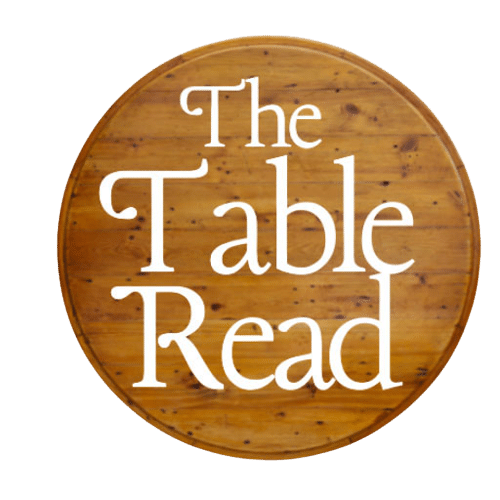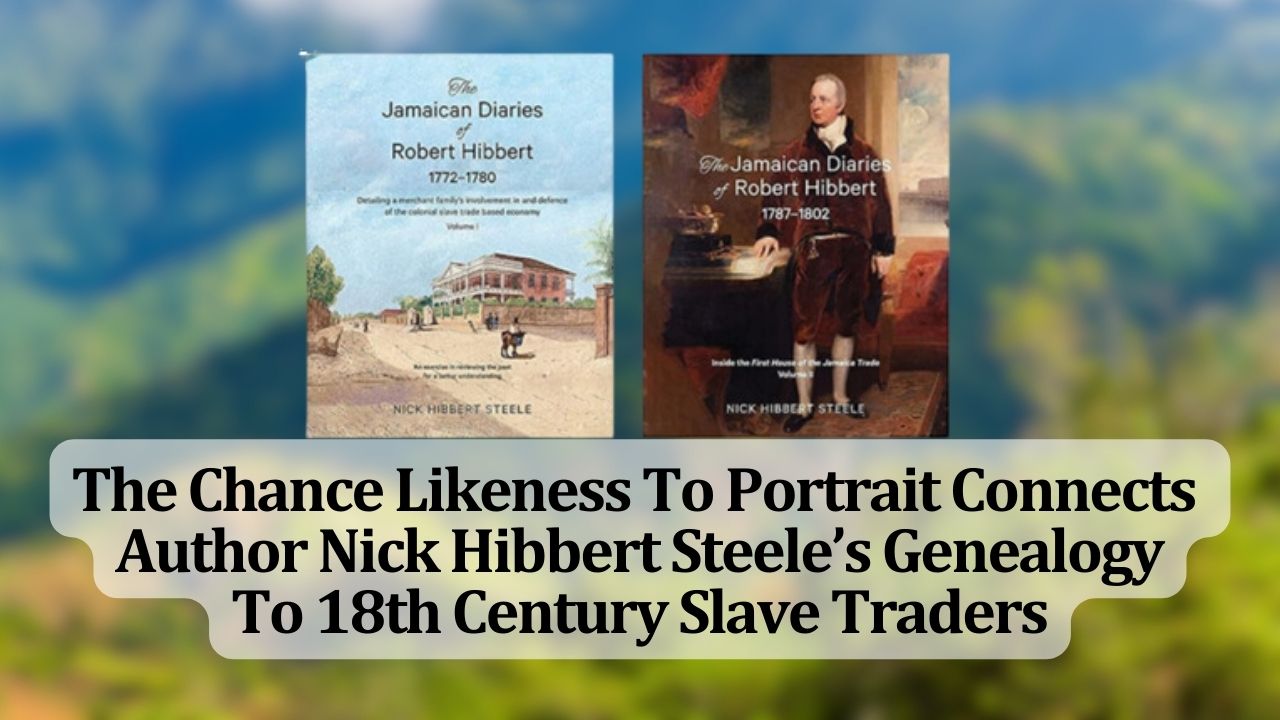On The Table Read Magazine, “the best book magazine in the UK“, Nick Hibbert Steele’s The Jamaican Diaries of Robert Hibbert reveal an ancestral story that many would hide from public scrutiny, as the family of slave traders during the 18 th and 19th centuries.
Robert Hibbert
Nick Hibbert Steele’s genealogical treasure hunt unearthed family truths very different to those that may have been envisaged. He shares the historically significant fallout of his ancestral history in a two-volume (of three) series, The Jamaican Diaries of Robert Hibbert, which recounts the life and work of his titular antecedent. Nothing could be more topical in today’s politically charged atmosphere of Black Lives Matter than fuelling the debate about slave reparations against a backdrop of White Privileged Colonialism exposed.
Nick shares how it was the likeness between himself and a portrait of George Hibbert (a younger brother of Robert and painted in 1811, but visible in an old photograph the author stumbled upon) which provided the catalyst for him to investigate his family history. The first two volumes are made more intriguing when set against today’s cancel culture climate.
Whether the publication of the diaries should be considered a brave or a foolhardy move, or a genuine attempt to make private records available, Nick Hibbert Steele does not shy away from his ancestry, nor does he bury his head in the sand in the hope that Robert Hibbert can be simply be erased from history. As it says on the cover of volume I, it’s An exercise in reviewing the past for a better understanding.

The Jamaican Diaries of Robert Hibbert 1772-1780
A deeply personal work that has evolved over the last 15 years, The Jamaican Diaries of Robert Hibbert 1772–1780 is intended to foster a greater understanding of a very difficult time in history, in which the enslaved and the enslavers inhabit different, disturbing interlocking narratives, now distorted by time and politics. At its core is the dark stain of an empire and many fortunes built upon the enslavement of the unfortunate.
It contains much thorough research into people, places, events and sources that developed as the author followed the twists and turns of a family history often frustratingly opaque and sometimes sensationally public.
The book is part genealogy and part social history: a previously unpublished diary of a major figure in the West Indian slave trade, with contemporary sources and biographical notes on those that strutted the Atlantic world of the late eighteenth century. It lays down a chronology to allow a picture of the day-to-day happenings in Jamaica to emerge.
This work exposes the deep, raw wounds that have resonated through the centuries, creating a need for a deeper study into many facets of British Atlantic history from a different perspective – one in which the narrative of the enslaved and the enslavers can be read together in both the geopolitical context of the times and the legal, ethical, humanitarian and religious belief systems of those times on both sides of the Atlantic.
In order to consider how the slave trade was run, financed, organised and evolved, the author provides a detailed examination of the Jamaican economy of the time, and offers a better and more balanced understanding of the slave trade’s establishment, adoption, adaption, abolition and, lastly, its legacy, in all its hydra-like forms.

The Jamaican Diaries of Robert Hibbert 1787-1802
The slave trade through the lens of one family’s intergenerational involvement, from the establishment of the business in 1734 until the death of Thomas Hibbert, the patriarch, in 1780. With no legal heirs, the next generation of West India merchants, plantation, slave owners and traders were his nine nephews, eight of whom were actively involved with George Hibbert (cover portrait) coming to dominate West India commerce and politics..
Volume II beginning in 1787, traces the establishment of what became known as ‘The First House of the Jamaica Trade’, and outlines its dominance in the slave trade, West India produce, and finance. The vertical integration of the business with the inception/foundation of the West India Dock is explored, as are the connections with other West Indies traders linked by marriage, commerce, or both.
Through the incorporation of aspects of social history and genealogy, the inclusion of artworks, and the use of primary materials, the author describes British Atlantic history through one family’s involvement. It introduces William Wilberforce’s great opponent, George Hibbert, who effectively delayed abolition until compensation was on the table. Surprisingly, the family’s association with Jamaica continued for three decades after abolition.
The diaries for 1781-86 are missing. Covering the years 1787 to 1802, the diaries reproduced here include harrowing accounts of Atlantic crossings, as well as much information about the day-to-day lives of the family, both in Jamaica and in England.
Nick Hibbert Steele
When I started researching my family history little did I expect to find slave owners or traders in my family and a hundred-year intergenerational association with Jamaica. A family that frustrated William Wilberforce’s attempt to end slavery from his first speech in 1789 to the Wilberforce Act of 1807, even then, slavery was not ended until George Hibbert (brother of Robert) convinced the Government pay the Slave owners, not the slaves, £20,000,000 compensation. (£7 Billion today).
It was a chance finding of an old black and white published photo of a portrait of George Hibbert painted in 1811, with an extraordinary likeness to me, that started my 30-year odyssey to establish and document the truth of the untold history of the pro slaving lobby and why it took 66 years and £20 million to end a slave trade that should have been abolished after the Mansfield decision of 1772, (brought to life in the film Belle, 2013).
As it says in the opening lines of The Go Between, ‘The past is a foreign country, they do things differently there’, and whatever you thought you knew about the slave tradeis radically different to its reality. At no stage do I try and justify the unjustifiable or run a revisionist agenda. My aim is to present family documents, and in particular the previously unseen Robert Hibbert diaries. The Diaries span from first arriving in Jamaica (1772) to join the Hibbert slave trading house founded by his uncle in 1734, to retiring to England around 1794 after traversing the Atlantic eight times.
Still with several Plantations in Jamaica and current and past interests in about 60 plantations and pens, Robert Hibbert passes his time in retirement as landed proprietor in the shires.
When Robert Hibbert (one of six brothers all involved in, The First House of the Jamaica Trade) retires, his younger brother, George, firstly becomes an Alderman of the City of London, and then lobbies for an Act of Parliament to build the West India Docks, which he chaired and opened for business in 1802. George then stood for parliament representing the rotten borough of Seaford to take the pro slaving lobby and argument to parliament in a vain attempt to stop Wilberforce.
George’s evidence to Parliament (1790) followed his speech at the London Tavern (with William Innes) The Slave Trade Indispensable, is reproduced in full in volume II of the diaries.
-Nick Hibbert Steele
Born in London, Nick Hibbert Steele has been a resident of Australia for the last 35 years, and is very active in researching a family history that many would have avoided. When asked about the remarkable likeness of two people united by name manifested in an image 200 years old, he said, ‘When I saw the portrait…I just had to follow the history. Beware of your ancestors. When you start rummaging through your ancestry you must be prepared to confront the unthinkable. Do you rebury the past or do you examine the history through a new lens of previously unseen documents?’ For a number of years Nick has been a contributor to the Slave Voyages Database.
Find more from Nick Hibbert Steele now:
Slave Voyages Database: www.slavevoyages.org
The Jamaican Diaries of Robert Hibbert 1772–1780: https://amzn.to/405yUeE
The Jamaican Diaries of Robert Hibbert 1787-1802: https://amzn.to/3Fmcr3s
We strive to keep The Table Read free for both our readers and our contributors. If you have enjoyed our work, please consider donating to help keep The Table Read going!





